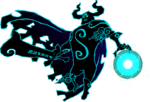Sub-Boss: Difference between revisions
Jump to navigation
Jump to search
No edit summary |
(Adding a bit on the term "midboss", just in case.) |
||
| Line 1: | Line 1: | ||
A '''mini-boss''' is generally one particular enemy or a group of common enemies which are harder to defeat. They usually protect an item within a [[dungeon]] or other locations such as equipment or must be defeated for Link to proceed within a dungeon. An example would be the [[Stalfos]] in {{OOT}} which one guards a small key, while another set guards the dungeon treasure, the [[Bow|Fairy Bow]]. | A '''mini-boss''' (also known as a '''midboss''') is generally one particular enemy or a group of common enemies which are harder to defeat. They usually protect an item within a [[dungeon]] or other locations such as equipment or must be defeated for Link to proceed within a dungeon. An example would be the [[Stalfos]] in {{OOT}} which one guards a small key, while another set guards the dungeon treasure, the [[Bow|Fairy Bow]]. | ||
A common characteristic for distinguishes a mini-boss from a regular enemy is a particular battle theme played during the encounter, which is different from the usual enemy theme. Other important aspects include: | A common characteristic for distinguishes a mini-boss from a regular enemy is a particular battle theme played during the encounter, which is different from the usual enemy theme. Other important aspects include: | ||
| Line 197: | Line 197: | ||
*[[Ball and Chain Soldier|Fire Ball and Chain Soldier]] | *[[Ball and Chain Soldier|Fire Ball and Chain Soldier]] | ||
*[[Arrghus]] | *[[Arrghus]] | ||
==Trivia== | |||
*The soundtrack for Ocarina of Time, as well as the guides for Twilight Princess and Skyward Sword, refer to minibosses as ''midbosses''. The term, however, is slightly incorrect, as minibosses do not necessarily mark the middle of a dungeon. | |||
Revision as of 12:50, 4 June 2015
A mini-boss (also known as a midboss) is generally one particular enemy or a group of common enemies which are harder to defeat. They usually protect an item within a dungeon or other locations such as equipment or must be defeated for Link to proceed within a dungeon. An example would be the Stalfos in Template:OOT which one guards a small key, while another set guards the dungeon treasure, the Fairy Bow.
A common characteristic for distinguishes a mini-boss from a regular enemy is a particular battle theme played during the encounter, which is different from the usual enemy theme. Other important aspects include:
- They may have appeared previously as main bosses.
- They may return later as common enemies, likely because Link will have new tools and weapons to defeat them more easily.
- They may come in groups, as in the case of common enemies.
- If they are in a dungeon, they need to be fought to complete it.
- If they are in a room, it is locked until they are defeated.
- They need to be defeated to access, obtain or unlock something.
- They may be optional and so don't need to be fought to complete the main game.
Minibosses in Zelda Games
The Legend of Zelda
- Almost every boss is eventually fought again as minibosses, as they no longer guard Heart Containers or Triforce fragments in their later appearances.
- Blue Gohma
- Patra
The Adventure of Link
- The Iron Knuckle boss also known as Rebonack returns as a mini-boss in the Three-Eye Rock Palace.
- Horsehead appears a second time as a mini-boss in the Palace on the Sea but only in the Japanese version of the game.
A Link to the Past
- Ball and Chain Trooper
- The first three bosses of the game (Armos Statues, Lanmolas and Moldorm) return in Ganon's Tower as mini-bosses.
- In the Palace of the Four Sword (exclusive to the Game Boy Advance version), the first four bosses from the Dark World dungeons (Helmasaur King, Arrghus, Mothula and Blind the Thief) return as stronger mini-bosses.
Link's Awakening
Ocarina of Time
Majora's Mask
- Dinofols
- Gekko (who fights Link along with a Snapper in Woodfall Temple, and along with samples of Mad Jelly in Great Bay Temple).
- Wizzrobe (icy variation in Snowhead Temple, fiery variation in Ancient Castle of Ikana).
- Gerudo Pirate
- Wart
- Captain Keeta
- Iron Knuckle
- Big Poe
- Igos du Ikana Servants
- King Igos du Ikana
- Garo Master
- Gomess
- Poe Sisters
Oracle of Ages
Oracle of Seasons
The Wind Waker
Four Sword Adventures
- Chief Soldier
- Shadow Link
- Manhandla
- Dodongos
- Big Dark Stalfos
- Gohma
- Ball and Chain Soldiers
- Big Dodongo
The Minish Cap
Twilight Princess
- Ook
- King Bulblin & Lord Bullbo
- Dangoro
- Twilit Carrier Kargarok
- Twilit Bloat
- Deku Toad
- Skull Kid & Puppets
- Death Sword
- Darkhammer
- Darknut
- Aeralfos
- Phantom Zant
Phantom Hourglass
Spirit Tracks
Skyward Sword
- Stalfos
- Lizalfos
- Stalmaster
- Moldarach (second fight)
- Scervo
- Magmanos
- Dark Lizalfos
- Moldorm
- Metal Shield Moblin
- Dreadfuse
A Link Between Worlds
- Armos
- Stalfos
- Heedles
- Goriyas
- Gigabari
- Gibdos & Mini-Moldorms
- Eyegores
- Devalants
- Big Pengator & Pengators
- Fire Gimos
- Template:C
- Gigabari
- Fire Ball and Chain Soldier
- Arrghus
Trivia
- The soundtrack for Ocarina of Time, as well as the guides for Twilight Princess and Skyward Sword, refer to minibosses as midbosses. The term, however, is slightly incorrect, as minibosses do not necessarily mark the middle of a dungeon.
